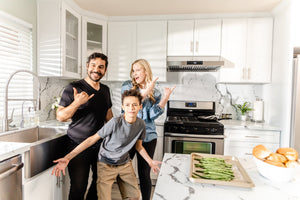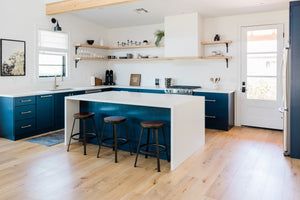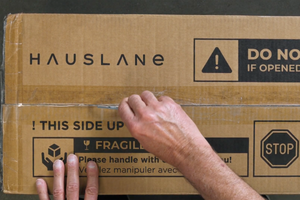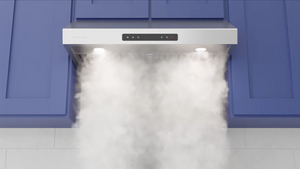How to Install a Range Hood through a Ceiling and Other FAQs
Got questions about range hood installation? We have answers. We’re sharing the six most frequently asked questions we get from customers, including ceiling mount installation, ductless range hoods, and more.
What We'll Cover:


1. Can You Install a Range Hood by Yourself?
Yes, it’s completely possible to install a range hood by yourself. We have several guides to help you do so:
- How to Install Hauslane's Chef Series UC-PS18 Under Cabinet Range Hood
- How to Install the UC-PS38 Range Hood
- DIY Guide to Removing your Over-the-Range Microwave and Installing an Under Cabinet Range Hood
- How to Install a Ductless Range Hood
- Easy DIY Range Hood Installation Guide for Wall Mount Range Hoods
In question three, you’ll see our guide for installing a range hood through the ceiling.

2. Is it Better to Mount a Range Hood to the Ceiling or to the Wall?
The choice between mounting a hood to the ceiling or the wall depends on several factors, including the layout of your kitchen, the type of cooktop or range you have, and your personal preferences.
Ceiling-mounted hoods are often used in kitchens with island cooktops, where there's no wall to mount the hood. Ceiling-mounted hoods can provide a sleek, modern look and can be a great focal point in the kitchen. They can also be more effective at capturing smoke and steam from the cooktop since they're positioned closer to the source.
Wall-mounted hoods are often used in kitchens with range cooktops located against a wall. They can be less expensive than ceiling-mounted hoods and may be easier to install since they don't require ductwork to be run through the ceiling. Wall-mounted hoods can also be more flexible in terms of placement and can be installed at various heights depending on your preferences.

3. How Do You Install a Range Hood through a Ceiling?
Installing a range hood through a ceiling involves a few steps and requires some tools and materials. Let’s take a look at a general guide for doing so:
Materials:
- Range hood
- Ductwork (rigid or flexible)
- Roof cap
- Roof flashing
- Roofing nails
- Roofing tar
- Wire nuts
- Screws
- Metal hanger straps
Tools:
- Power drill
- Hole saw or reciprocating saw
- Tin snips
- Screwdriver
- Level
- Measuring tape
- Pencil
Steps:
- Choose the location where you want to install the range hood. It should be above the cooktop or range, and there should be enough clearance between the range hood and the range top.
- Measure the distance from the range hood to the roof.
- Use a stud finder to locate the ceiling joists where you'll mount the range hood.
- Cut a hole in the ceiling using a hole saw or reciprocating saw, following the manufacturer's instructions for the size of the hole.
- Install the roof cap on the roof according to the manufacturer's instructions.
- Install the roof flashing around the roof cap and seal it with roofing tar.
- Cut a hole in the roof cap to match the size of the ductwork.
- Install the ductwork through the hole in the ceiling and the roof cap, making sure it's secured with metal hanger straps.
- Connect the ductwork to the range hood using screws and wire nuts, following the manufacturer's instructions.
- Mount the range hood onto the ceiling joists using screws and a level to ensure it's level.
- Install the range hood cover and turn on the power to test it.
It's important to follow all manufacturer's instructions and local building codes when installing a range hood through a ceiling. If you're not comfortable with any step of the installation process, it's best to hire a professional installer.

4. How Do Wall Mount Range Hoods Work?
Wall mount range hoods work by drawing smoke, steam, and odors away from the cooking surface and venting them outside of the home. Here's how they work:
- The range hood is mounted to the wall above the cooktop or range.
- When the cooktop is turned on, smoke and steam rise from the cooking surface.
- The range hood has a fan that draws in the smoke and steam through a metal mesh or baffle filter.
- The filter traps grease and other particles while allowing air to pass through.
- The air then passes through ductwork that runs through the wall and outside of the home.
- The air is vented outside through a vent cap or hood on the exterior of the home.
- The venting process removes the smoke, steam, and odors from the kitchen, keeping the air clean and fresh.

5. Do Range Hoods Need to Be Vented?
Range hoods do not necessarily need to be vented, but venting can help provide optimal performance and to remove smoke, steam, and odors from the kitchen.
Vented, or ducted range hoods remove the airborne particles and odors from the kitchen and exhausts them outside. This is done through ductwork that connects the range hood to an exterior vent on the roof or wall.
If you can’t vent your range hood, you can use a ductless range hood that recirculates air through filters instead of venting outside. However, ductless range hoods are not always as effective at removing smoke, steam, and odors from the kitchen as vented range hoods.

6. Can I Mount a Ductless Range Hood?
Yes, you can mount a ductless hood. They are actually easier to install than ducted range hoods because they do not require ductwork to be installed through walls or ceilings. To mount a ductless range hood, follow these steps:
- Determine the location: Choose the location where you want to mount the ductless range hood. Make sure that it is centered over the cooking surface and at least 18-24 inches above the cooktop or range.
- Install the mounting bracket: Use a drill to install the mounting bracket onto the wall. Make sure that the bracket is level and securely attached to the wall studs.
- Mount the range hood: Once the bracket is installed, attach the range hood to the bracket using screws. Double-check that the range hood is level and securely attached to the bracket.
- Install the filters: Ductless range hoods use charcoal or carbon filters to purify the air. Follow the manufacturer's instructions to install the filters inside the range hood.
- Connect the range hood: Ductless range hoods typically plug into an electrical outlet. Follow the manufacturer's instructions to connect the range hood to the electrical supply.
- Test the range hood: Turn on the range hood and test it to make sure that it is working properly. Check that the fan is drawing in air and that the filters are working to remove smoke, steam, and odors.
Be sure to refer to the manufacturer's instructions for specific guidance and safety precautions.
Wondering whether it’s time to upgrade your range hood? We share our top reasons for updating your current model for better performance and style.








